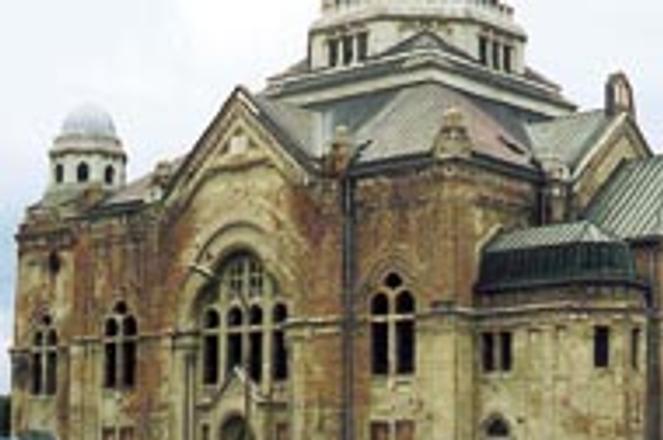What fate awaits? Empty, forgotten synagogues all over Slovakia, like this huge one in Lučenec, are a powerful reminder of the deportation of Jews out of the country during WW2. Now they wait for city and state officials along with the Jewish community to decide how they will be put to use.Rachel Hammonds
Slovakia was a home to more than 70,000 Jews before War World II. Less than 3,000 of them survived the war. What has remained after all these years are the synagogues, Jewish houses of prayer, which have been left behind empty, in terrible shape waiting to be used again.
There are approximately 120 synagogues still standing in one shape or another around the country. These buildings are what's left from the regime that tried to destroy them. During communism most of them were used as storage warehouses for agricultural or chemical products, some were made into movie theaters, or cultural centers, and most just hidden behind tall concrete walls.
There are not enough Jews to use these Synagogues today and a new purpose hasn't been found for these giant landmarks. A small percentage of the synagogues are being reconstructed by the Slovak National Museum (SNM) and its Section on Jewish Culture, along with help from the Ministry of Culture, and by the Central Association of Jewish Religious Communities (ÚZŽNO). But there has been little interest in the synagogues since cities don't quite know what to do with them and the Jewish community is more concerned with recovering cemeteries.
Synagogues in Prešov, Žilina, Trnava and Trenčín have been reconstructed by the SNM in cooperation with the Ministry of Culture. They are now being used as museums, galleries or as concert halls. Each has an exhibition called Judaík, which reminds people of what happened to the Jews while giving a glimpse of who these Jews were who lived and worshiped in the region.
But the fate of most synagogues is difficult to know. Usually the town where the synagogue is located starts the long process of reconstruction. "City hall in a town with a synagogue, usually makes a request to us to find a new purpose for the crumbled building, and to then do reconstruction," said Pavol Mešťan, director of the SNM's section of Jewish Culture.
"The next step is to find out who the owner of the synagogue is, and then to approach the Ministry of Culture with a plan for reconstruction and future use," said Mešťan. "It is very hard to find out who the actual owner of the building is," said Mešťan. "Most synagogues are owned by ÚZŽNO, but not always. Over a 50-year period these synagogues have changed their owner many times."
ÚZŽNO owns more than 30 synagogues, leasing the ones that have captured the interest of towns for about 50 years to state institutions. Interest has not been great but SNM plans to reconstruct synagogues in Spišské Podhradie, Šurany and Nitra. There are also plans to preserve the synagogues in Lučenec and Levice, according to Mešťan.
Jozef Weiss, director of ÚZŽNO, said that it was important to keep synagogues preserved for future generations but admitted that ÚZŽNO was not doing much to push the process along because synagogues do not hold the spiritual importance of Jewish cemeteries. Because of this, Weiss thinks more could be done with synagogues. "If you know Jewish law, a synagogue is not considered to be a sacred place after people stop worshipping there," he explained. "Synagogues are different from the cemeteries. Jewish cemeteries are sacred places even when people stop being buried there anymore," he added.


